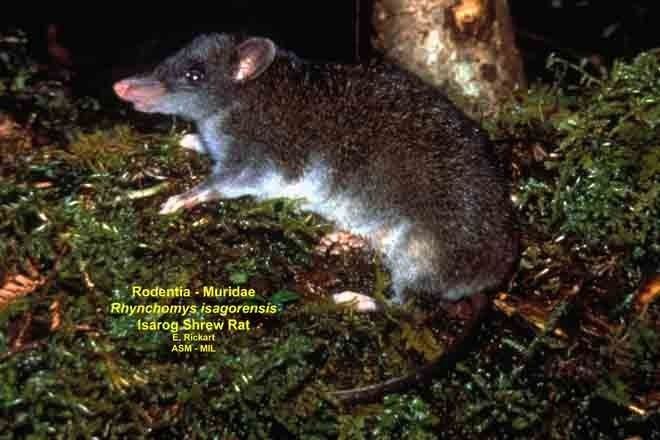Subfamily Murinae Higher classification Murinae | Phylum Chordata Scientific name Rhynchomys Rank Genus | |
 | ||
Lower classifications Mount Data shrew rat, Isarog shrew rat | ||
The shrewlike rats, genus Rhynchomys, also known as the tweezer-beaked rats are a group of unusual Old World rats found only on the island of Luzon in the Philippines. They look a great deal like shrews and are an example of convergent evolution. Shrewlike rats evolved to be vermivores (worm-eaters) and insectivores feeding on soft-bodied invertebrates associated with leaf litter.
Contents
Characteristics
The snout and rostrum are very long. Eyes are small. Head and body is 18.8–21.5 cm with a tail 10.5–14.6 cm (Nowak, 1999). Only two molars are present; these are small and peg-like. Incisors are described as needle-like and mandibles as delicate (Nowak, 1999; Balete et al., 2007).
Distribution
Shrewlike rats are found at elevations of 1,100 to 2,460 meters (Nowak, 1999; Balete et al., 2007). They are restricted to moist, mossy highland regions with ample rainfall and large populations of earthworms. Populations appear to be very isolated, restricted to "sky islands" of Luzon. Specimens have been collected from Mount Bali-it and Mount Data of the Central Cordillera (R. soricoides), Mount Tapulao of the Zambales Mountains (R. tapulao), Mount Banahao (R. banahao), and Mount Isarog (R. isarogensis; Balete et al., 2007).
Relationships
Musser and Heaney (1992) recognized Rhynchomys as an Old Endemic of the Philippines. They considered the genus distinct enough to give it its own group distinct from all other Old Endemics. Musser and Carleton (2005) classified it as part of the Chrotomys Division along with Apomys, Archboldomys, and Chrotomys. Jansa et al. (2006) supported this relationship and determined that within this division, Rhynchomys is most closely related to the other Philippine shrew-rats in the genus Archboldomys and Chrotomys.
Species
From 1895 until 1981, Rhynchomys was only known from a few specimens taken from near the type locality of R. soricoides. In 1981, this was expanded by one species with the discovery and description of R. isarogensis. In April, 2007, Balete and colleagues described two additional species, R. banahao and R. tapulao from Mount Banahao and Mount Tapulao, respectively.
